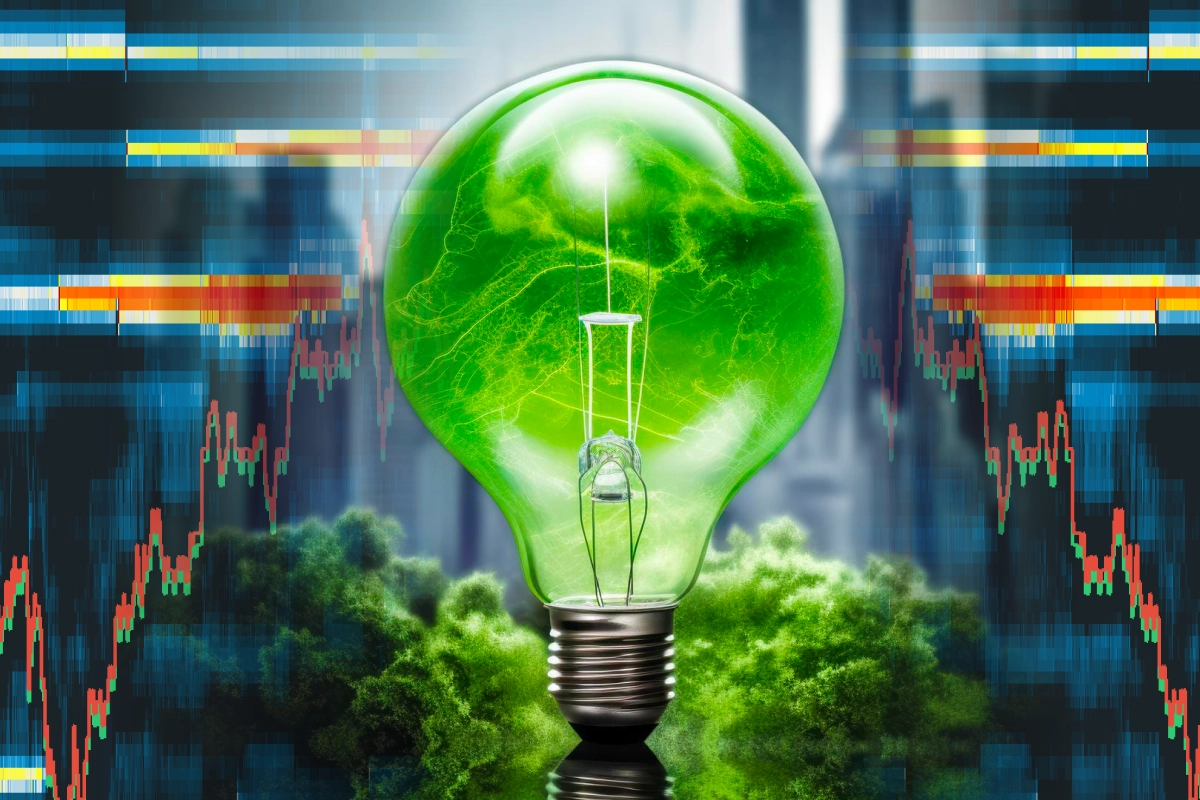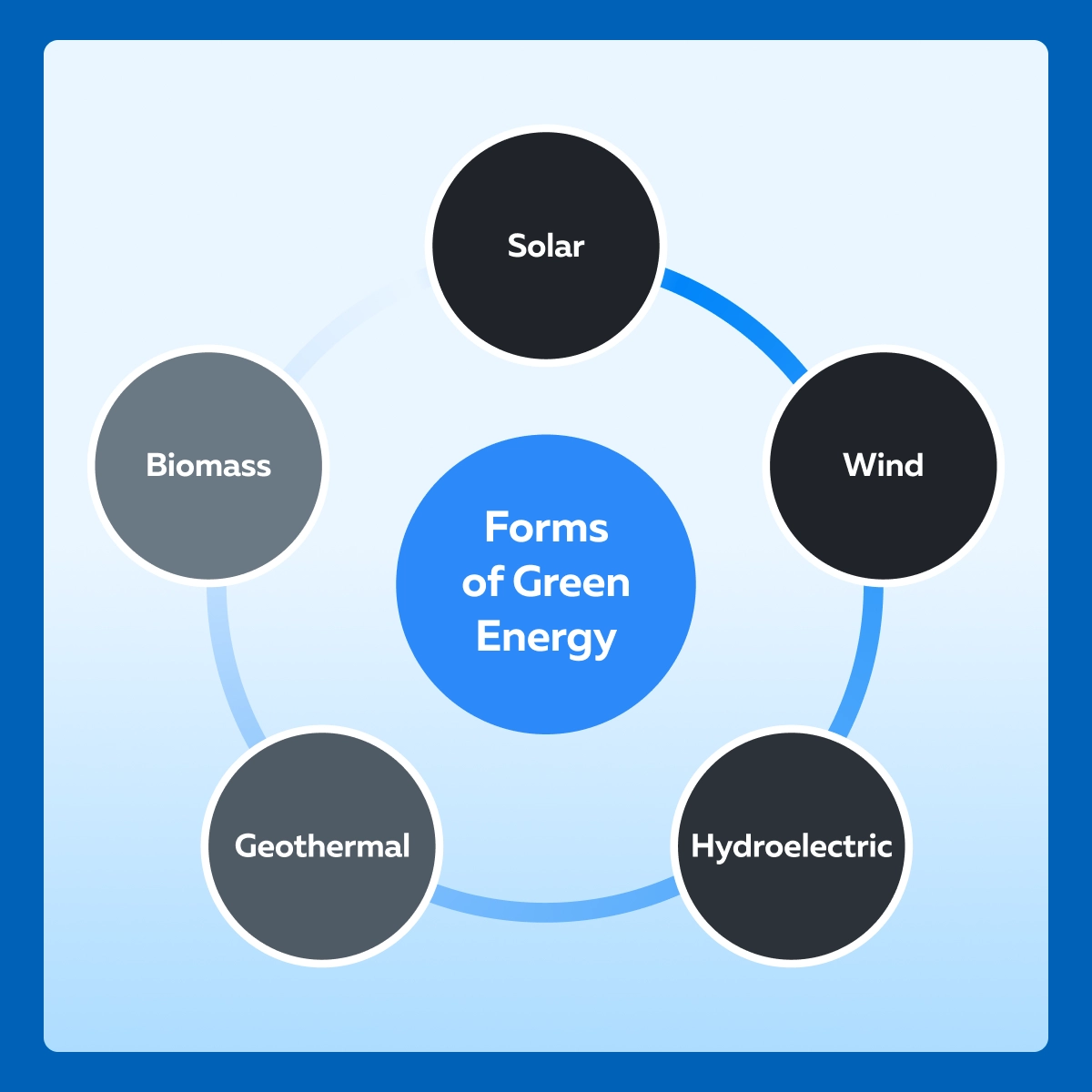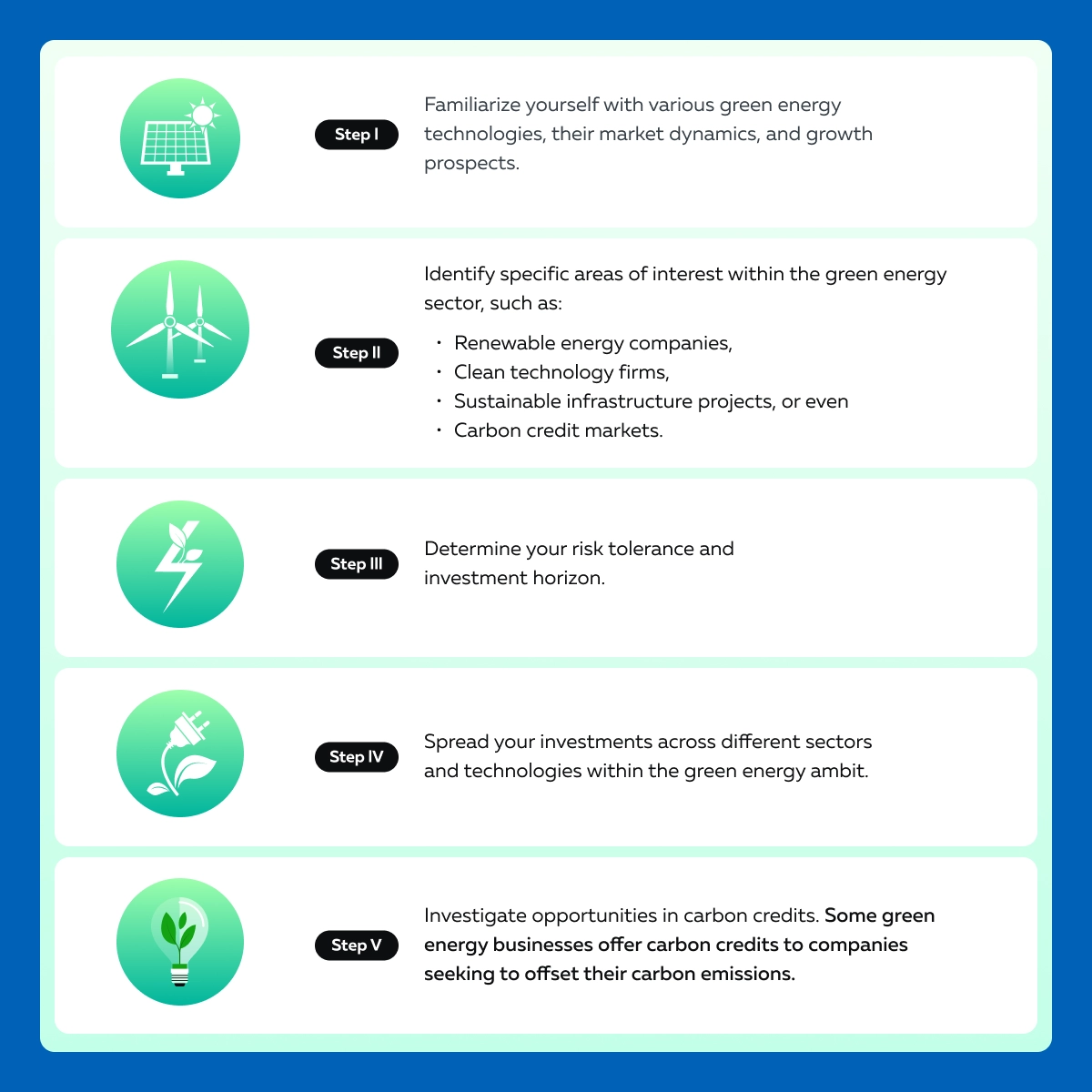Ready to see the market clearly?
Sign up now and make smarter trades today
Education
March 29, 2024
SHARE
The Green Energy Revolution: Transforming Global Markets and Investment Prospects
Do you know Green energy contributes 67% of Sweden’s electricity supply, and the country aims to be 100% fossil-fuel-free by 2050? Additionally, Germany has set targets of 80% renewable power by 2030 and close to 100% by 2035. These statistics make it quite evident that the world is adopting green energy at a rapid pace.
But have you, as an investor, made any effort to adjust your portfolio? In this article, we will understand what green energy is and explore some key growth areas like electric vehicles, energy storage, and sustainable infrastructure. We’ll also see the associated pros, and cons, the impact of regulatory changes, and some popular investment opportunities. Let’s get started.
The Green Energy Landscape
Green energy refers to power generated from renewable, environmentally friendly sources. These sources are characterized by their:
- Low impact on the environment and
- Ability to replenish themselves over time.

Let’s understand the various forms of green energy:
- Solar Energy:
- It is captured from the sun’s rays through photovoltaic cells.
- It is a versatile and sustainable source used for electricity and heating.
- Wind Energy:
- This source utilizes the kinetic energy from the wind.
- The wind turbines generate electricity without emitting greenhouse gases.
- Such zero emission makes it a clean source of energy.
- Hydroelectric Energy:
- It represents energy derived from the movement of water.
- Hydroelectric power is generated by dams and turbines.
- Geothermal Energy:
- By tapping into the Earth’s internal heat, geothermal power plants convert steam or hot water into electricity.
- This is a stable and continuous source of energy supply.
- Biomass Energy:
- This form of energy is derived from organic materials like:
- Wood,
- Agricultural residues, and
- Organic waste from households and industries.
- Biomass energy can be converted into heat or electricity, thereby reducing reliance on fossil fuels.
- This form of energy is derived from organic materials like:
The Environmental and Economic Benefits of Green Energy
Owing to greater acceptance and increasing reliance, green energy is poised to play a pivotal role in shaping the future of energy production and consumption.
Read the table below to understand the environmental and economic benefits of green energy:
| Environmental Benefits | Economic Benefits |
| Green energy sources produce minimal or zero greenhouse gas emissions. | The green energy sector has created new jobs, ranging from manufacturing and installation to research and development. |
| Unlike fossil fuels, green energy relies on resources that are naturally replenished. This reliance ensures sustainability and avoids resource depletion. | By investing in green energy, countries can reduce dependence on imported fossil fuels. Such an act enhances energy security and stability. |
| Green energy projects have a lower impact on ecosystems compared to traditional energy sources. | Advances in technology have reduced the cost of green energy production. This cost-effectiveness has made it increasingly competitive with conventional energy sources. |
Rapid Growth of Green Energy in Numbers
Renewable energy is one of the fastest-growing sectors globally. Let us have a look at some recent statistics that highlight the rapid expansion of the green energy sector:
- According to the Energy Information Administration, renewable deployment is expected to:
- Grow by 17% to 42 GW in 2024 and
- Account for almost a quarter of electricity generation.
- The IEA predicts that renewable energy sources will account for over 42% of global electricity generation in 2028 and the share of wind and solar PV will double to 25%.
- Statista Market Forecast projects that electricity generation in the renewable energy market will amount to 7,295.00bn KWh in 2024, with an expected annual growth rate of 3.88%.
- The global renewable power capacity is expected to grow by 2,400 GW over the 2022-2027 period, an amount equal to the entire power capacity of the United States.
Impact on Global Markets
The transition to green energy from conventional sources has both direct and indirect effects on financial markets. Let’s understand the major ones through the table below:
| Direct Effects | Indirect Effects |
|
|
|
|
How Do Government Policies and Regulations Get Impacted?
To promote green energy, governments worldwide are offering financial incentives and subsidies to encourage its adoption. This impacts market dynamics by making renewable projects financially attractive.
Additionally, governments implement:
- Carbon pricing mechanisms, such as cap-and-trade systems or carbon taxes, influence market behavior by placing a cost on carbon emissions. Such an implementation encourages businesses to invest in cleaner technologies and practices.
- Renewable Portfolio Standards (RPS) and renewable energy targets, require a certain percentage of energy to come from renewable sources. Compliance with these standards affects market dynamics and shapes investment strategies.
The Growing Adaptation of Green Energy
Traditional energy sectors are increasingly adopting green energy for a more sustainable and diversified future of energy consumption. Let’s see how they are making this shift:
- Traditional energy companies are diversifying their portfolios by investing in or acquiring green energy assets.
- Some traditional energy companies are gradually shifting towards cleaner technologies, such as natural gas, which produces fewer emissions compared to coal or oil.
- Initiatives like Carbon Capture and Storage (CCS) allow traditional fossil fuel-based industries to continue operating while mitigating their environmental impact. This adaptation strategy reduces carbon emissions from existing operations.
Investment Opportunities in Green Energy

Due to increased popularity and surge in interest, green energy investments offer significant opportunities to earn smart returns. Let’s see some key areas for investment:
| Where to Invest? | Why to Invest? |
| Renewable Energy Companies |
|
| Clean Technology Firms |
|
| Sustainable Infrastructure Projects |
|
| Energy Storage Solutions |
|
| Carbon Capture and Storage (CCS) |
|
Potential for Long-Term Growth and Returns
The ongoing global shift towards renewable energy and sustainability is a powerful driver for long-term growth in green energy investments. As nations commit to reducing carbon emissions, the demand for clean energy solutions is likely to grow substantially. Also, these continued advancements in green technology will drive sustained growth in the sector:
- Improved solar and wind technologies,
- More efficient energy storage, and
- Innovative solutions for carbon reduction.
Furthermore, the growing emphasis on Environmental, Social, and Governance (ESG) considerations in investment decisions makes green energy investments a favorite. In the coming future, investors will prioritize companies with strong sustainability practices.
Global Disruption and Cause-Effect Dynamics
When it comes to green energy, it is important to note that “cause and effect” is significant, and green energy is disrupting markets on a global scale. Let’s see how:
- Market Disruption
-
-
- Green energy is challenging the dominance of fossil fuels.
- This disruption is driven by a combination of:
- Technological advancements,
- Environmental imperatives, and
- Shifting consumer preferences.
-
- Supply Chain Shifts
-
-
- The transition to green energy is reshaping global supply chains, with increased demand for:
- Rare earth metals,
- Lithium, and
- Other critical components used in renewable energy technologies.
- This surge in demand creates new investment opportunities in the supply chain sector.
- The transition to green energy is reshaping global supply chains, with increased demand for:
-
- Energy Independence Movements
-
- Nations investing in green energy are:
- Enhancing their energy independence and
- Reducing reliance on geopolitically sensitive fossil fuel sources.
- This shift has geopolitical implications and can affect global economic and political dynamics.
- Nations investing in green energy are:
Risks and Challenges
The green energy investments offer significant opportunities. However, they aren’t free from potential risks and challenges. Read the table below to understand some common risks and the strategies to mitigate them:
| Green Energy Investment Risks | Explanation | Mitigation Strategy |
| Regulatory Changes |
|
|
| Technological Developments |
|
|
| Market Volatility | Green energy markets can be subject to volatility due to factors such as:
|
|
| Financing Challenges | Securing financing for large-scale green energy projects is challenging, especially during economic downturns or periods of uncertainty. |
|
| Supply Chain Disruptions | Dependence on specific critical components, such as rare earth metals, can expose investments to supply chain disruptions and price fluctuations. |
|
How to Navigate the Green Energy Investment Landscape
By combining thorough research, staying informed, and engaging with industry experts, investors can navigate the green energy investment landscape effectively. Let’s understand step-by-step how investors can get started with green energy investments:

Why is Practicing Due Diligence and Staying Informed Important?
For investors, thorough due diligence is crucial to understand the risks and potential returns associated with green energy investments. This involves evaluating the following:
- Financial health,
- Track record, and
- Sustainability practices of companies under consideration.
A comprehensive analysis to ensure that investments align with the financial goals and risk tolerance limits of investors. Further, to identify promising investment opportunities, investors must stay Informed about market trends and the latest breakthroughs in solar, wind, storage, and other technologies.
By acquiring knowledge of emerging technologies, investors can:
- Adapt their portfolios and
- Focus on innovations that can lead to significant market disruptions.
Now, let’s discuss some major areas that green investors must monitor:
| Key Areas to Monitor | Significance | Benefits |
| Policy and Regulatory Developments |
|
By anticipating regulatory changes, investors can assess potential risks and adjust their strategies accordingly. |
| International Agreements and Climate Policies | International agreements related to climate change, such as the Paris Agreement, significantly influence the green energy sector. | Investors who align their portfolios with international climate goals benefit from:
|
How to Stay Up to Date?
The investors can refer to the following sources:
- Industry publications and journals like “Renewable Energy World” and “Greentech Media”
- News outlets such as Bloomberg New Energy Finance (BNEF) and The Guardian’s Environment
- Reports from investment research firms like Morningstar, S&P Global, and Wood Mackenzie
Is It Worth Investing in Green Energy?
The increasing global focus on sustainability, coupled with technological advancements, suggests a promising future for the green energy sector. Investors with a long-term vision can benefit from adding green energy to their diversified investment portfolio. Such investors will find that green energy investments contribute not only to financial returns but also to a sustainable and responsible future.
However, understanding and mitigating risks associated with green energy investments is vital. Read the most relevant pros and cons below to broaden your knowledge base:
| Pros | Cons |
|
|
|
|
|
|
|
|
|
|
The Future of Green Energy Investments
Based on recent research reports, journals, and other popular publications concerning green energy, we speculate the following developments in the sector:
- The global push for carbon neutrality and sustainability is expected to drive further growth in renewable energy adoption.
- Governments and businesses will intensify efforts to transition away from fossil fuels. This shift will lead to increased investments in solar, wind, and other renewable sources.
- Ongoing technological innovations will lead to cost reductions in green energy technologies and will make them more competitive with traditional energy sources.
- The electric vehicle market is poised for substantial growth as automakers continue to invest in EV technology.
- Hydrogen will emerge as a clean fuel for various applications. Advances in green hydrogen production methods and supportive government policies will drive investments in this sector.
- Sustainable finance and impact investing will gain prominence. These investment options can become mainstream:
- Green bonds,
- ESG-focused funds, and
- Investments in companies with strong sustainability practices.
The Growth Areas and Emerging Trends
By identifying growth areas and spotting emerging trends, investors can recognize opportunities that align with their financial goals and a commitment to sustainability. Let’s understand better:
| Growth Areas | Reason | Investment Opportunities | Factors to Consider |
| Electric Vehicles (EVs) and Charging Infrastructure | Increasing global commitment to reduce carbon emissions and advancements in battery technology. | Invest in these companies:
|
|
| Energy Storage Solutions | Increasing demand for reliable and resilient energy systems. | Invest in:
|
|
| Sustainable Infrastructure Projects | Increasing awareness of the impact of infrastructure on climate change. | Invest in:
|
|
Conclusion
The green energy is poised to bring transformative change and reshape the global markets in the near future. Investors can earn smart returns by investing in growth areas, like hydrogen as a clean fuel, electric vehicles, energy storage solutions, and sustainable infrastructure projects.
Additionally, as governments intensify efforts to reduce carbon emissions and societies demand eco-friendly solutions, green energy investments are bound to emerge as financially sound choices.
However, investors must stay informed and regularly align their portfolios with technological and regulatory changes. Are you ready to develop your trading edge in the evolving green energy market? Explore strategies for gaining a competitive advantage in trading by clicking here.